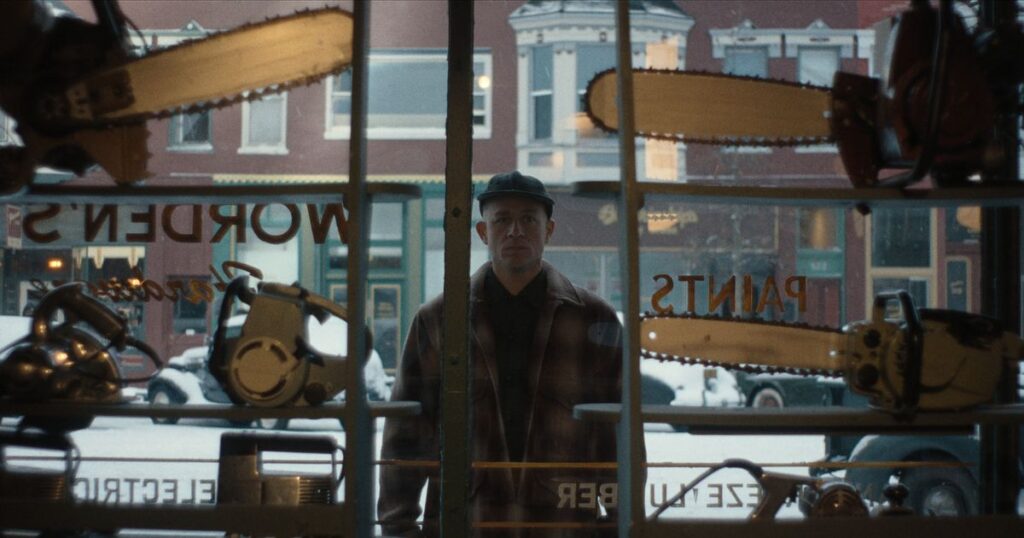**Ryan Murphy’s *Monster* Series: A Twisted Take on True Crime and Pop Culture**
Ryan Murphy’s adaptations based on true stories are known for taking liberties with the facts, and his *Monster* series is no exception. The first two seasons offered questionable interpretations of the lives of Jeffrey Dahmer and the Menendez brothers. However, the third installment, *The Ed Gein Story*, takes an intriguing approach by weaving the concept of multiple truths into its narrative. After all, Ed Gein’s real-life crimes inspired legendary fictional villains like Norman Bates (*Psycho*), Leatherface (*The Texas Chain Saw Massacre*), and Buffalo Bill (*The Silence of the Lambs*).
Rather than sticking closely to history, *Monster* offers heavily fictionalized interpretations of Gein’s crimes and extends its reach to explore how his gruesome acts rippled throughout pop culture. This approach creates ample room for deviation from the historical record. Ian Brennan, *Monster*’s co-creator and writer for all eight episodes this season, clearly delights in taking kernels of truth and spinning them into imaginative, popcorn-worthy tales.
Brennan shields himself from accusations of exaggeration by consistently reminding viewers that Ed Gein’s grip on reality is tenuous at best. Wondering whether a particular event actually happened? Perhaps it happened only in Ed’s mind. While some parts of the show are grounded in verifiable facts, anything unverifiable—or plausible only within Ed’s hallucinations—is fair game for *Monster*’s grisly fantasia.
—
### Ed Gein (Charlie Hunnam): The Butcher of Plainfield
Ed Gein is infamous not only for murdering at least two women but for what he did with their bodies and those he exhumed from local cemeteries. When authorities raided his home in 1957, they found horrifying items such as a wastebasket made of human skin, skull bowls, a nipple belt, a lampshade crafted from a human face, and nine vulvas stored in a shoebox.
Most of these body parts were taken from graves, but also from the two women he killed: Mary Hogan and Bernice Worden. Mary’s face was used by Ed as a mask, and Bernice’s entire head was discovered. *Monster* incorporates these chilling details faithfully.
The show remains fairly consistent with Gein’s admitted atrocities—such as hanging Bernice’s body in a shed, shooting Mary Hogan, and grave-robbing. However, it presents as fact several crimes he was only suspected of, including the disappearance of Evelyn Hartley, the presumed chainsaw murders of hunters Victor Travis and Raymond Burgess (which *Monster* connects to the origin of Leatherface), and even the death of Ed’s brother Henry. Though Henry’s death was ruled as asphyxiation with some questionable bruising found on his head, the show portrays it as Ed’s first assault.
Regarding Ed’s disturbing relationship with his mother, a 1957 psychological report explains that after her death, his emotional needs drove him to try to recreate his mother using body parts from graves. This aligns closely with *Monster*’s portrayal of Ed’s motivations. However, experts remain uncertain about the extent of Gein’s necrophilia, as he claimed he avoided sexual acts with exhumed bodies due to the smell. The truly unsettling scenes involving necrophilia in episode five, therefore, are speculative and depend on the viewer’s interpretation.
—
### Adeline Watkins (Suzanna Son): Fact vs. Fiction
*Monster* takes its most imaginative liberties with the character of Adeline Watkins, who is depicted as Ed’s on-and-off girlfriend for over twenty years—and much more.
In reality, little is known about Watkins beyond her brief claims in an interview that she dated Gein on and off, claims she later recanted, stating she never entered his house and they only went to the movies a handful of times.
In contrast, *Monster* portrays Adeline as a Lady Macbeth-like figure pushing Ed toward his monstrous acts. The fifth episode suggests she attacked someone in New York after meeting famous crime scene photographer Weegee (played by Elliott Gould), and intriguingly implies that her mother tried to kill her in utero by throwing herself down stairs multiple times.
Could this have happened? Theoretically yes, but more importantly, it’s *Monster*’s license to blend fact and fantasy. Adeline’s role extends further—she becomes a Marion Crane figure, with Ed spying on her Norman Bates-style, and she is later imagined brutally murdered in a shower in a version of *Psycho* that never existed.
Ultimately, Adeline is portrayed as an object of obsession, a partner in crime, a sociopath, and the girlfriend of a necrophiliac. The real Adeline was likely none of these, making her a perfect symbol of how truth becomes legend, and vice versa.
—
### Augusta Gein (Laurie Metcalf): The Religious Matriarch
Ed’s mother Augusta appears sparingly in *Monster*, often through Ed’s distorted visions and hallucinations. Historically, Augusta married George Gein and had two sons—Ed and Henry. She was known for her religious devotion, condemning what she saw as immoral behavior, especially among women—a trait the show captures in her character.
Following the deaths of George in 1940 and Henry in 1944, Ed was left alone with Augusta, which coincided with a marked decline in his mental health.
In a rare blending of fact and fiction, the show depicts an incident where Ed and Augusta witness a man abusing a dog—an event Ed himself recounted. However, the show exaggerates the consequences, such as Augusta’s sudden death at the scene, which is not historically accurate.
—
### Alfred Hitchcock (Tom Hollander): Master of Suspense Meets the Plainfield Ghoul
One of the most inventive aspects of *Monster* is its exploration of Ed Gein’s influence on pop culture icons. The show imagines Alfred Hitchcock’s fascination with the moral transgressions committed by the man who inspired Norman Bates.
In reality, *Psycho* was based on Robert Bloch’s novel loosely inspired by Gein. Hitchcock’s assistant Peggy Robertson was instrumental in bringing the film to Paramount, and Hitchcock even waived his director’s fee to get the movie approved.
*Monster* takes significant creative liberties—episode two depicts Hitchcock viewing a tumultuous screening of *Psycho* where audience members faint and vomit, as well as a graphic re-creation of the iconic shower scene featuring Ed and Adeline as Norman and Marion. The nudity and violence here far exceed that of the actual film.
Hitchcock’s wife Alma Reville, played in the show, is cast more as a judgmental observer than a creative collaborator, shaking her head at Alfred and voicing concerns over *Psycho*’s typecasting as “sex horror.” While Alma’s real-life partnership with Hitchcock was profound and productive, *Monster* uses her mostly as a device to highlight Alfred’s creative tensions.
—
### Anthony Perkins (Joey Pollari): A Tenuous Link
Hitchcock’s *Psycho* star Anthony Perkins is given even less narrative space, but the show draws a questionable connection between Perkins and Gein by implying a shared experience of secret cross-dressing.
Scenes depict Perkins cross-dressing with his boyfriend and receiving oral sex while watching *Psycho* on screen, suggesting parallels with Gein’s own behaviors. This portrayal feels exploitative and disrespectful to Perkins’ legacy.
The show is interested only in Perkins’ closeted status during his lifetime, drawing a crude and shallow link to Gein’s private proclivities—a connection that is both flimsy and distasteful.
—
### Tobe Hooper (Will Brill): The Texas Chainsaw Massacre Origins
Episode four fantasizes about how a young Tobe Hooper first learned about Ed Gein through his father, planting the seeds for *The Texas Chain Saw Massacre*.
Later, an adult Hooper is shown at a Montgomery Ward store pondering the idea of using a chainsaw as a weapon, followed by scenes incorporating Gein’s body suit stories into *Leatherface*’s vision on set.
While Hooper has acknowledged Gein’s influence on parts of *Texas Chain Saw Massacre*, the film also comments on misinformation and the Vietnam War—a nuance *Monster* nods to but does not deeply explore.
Hooper’s quote about telling a “true story that wasn’t really true” resonates ironically with *Monster*’s own approach.
—
### Bernice Worden (Lesley Manville): The Hardware Store Owner
Bernice Worden, a 58-year-old hardware store owner in Plainfield, vanished in November 1957. Her son, Deputy Sheriff Frank Worden, launched the investigation after discovering bloodstains and knowing Gein had visited her store the night she disappeared.
This investigation uncovered the macabre horrors in Gein’s farmhouse, including Bernice’s decapitated, flayed body hanging in a shed.
Bernice and Mary Hogan shared similar ages and backgrounds to Augusta Gein, possibly explaining Ed’s choice of victims.
*Monster* takes wild creative detours with Bernice’s character, imagining a sexual encounter involving Ed cross-dressing before the two engage in a disturbing sexual act. This depiction goes far beyond any known facts.
—
### Evelyn Hartley (Addison Rae): The Missing Babysitter
In October 1953, 14-year-old Evelyn Hartley disappeared in Wisconsin after being hired to babysit. Strange details surrounded her disappearance, such as locked rooms and a missing window screen with a stepladder outside. Despite searches, Evelyn’s body was never found.
Though Gein lived nearby and was questioned, no evidence linked him to her disappearance, and he was cleared.
*Monster* invents a storyline where Ed tries to prove he can be a father by securing a babysitting job—only to have the opportunity stolen by Evelyn. He stalks, kidnaps, and violently murders her in a brutal and graphic scene, highlighting the show’s willingness to blend fact with explicit fiction.
—
### Ilse Koch (Vicky Krieps): The Bitch of Buchenwald
German war criminal Ilse Koch, wife of the Buchenwald commandant, is another figure who arguably deserves her own *Monster* season.
In the show, Ed reads a comic book titled *The Bitch of Buchenwald*—given to him by Adeline—that fictionalizes Koch’s atrocities. The comic, and thus much of *Monster*’s depiction, exaggerates historical events, such as turning human skin into lampshades.
Although testimony during Koch’s 1947 trial accused her of horrific acts, many details remain unproven. *Monster* leans fully into the comic-book stylization, showing Koch as a hallucination within Ed’s mind.
In episode seven, Ed contacts Koch over ham radio before her prison suicide. While Koch’s suicide is factual, the imagined conversation is pure fiction and exemplifies the crumbling line between reality and Ed’s mental hallucinations in the series.
—
### Christine Jorgensen (Alanna Darby): A Moment of Reflection
As institutionalized Ed begins to grapple with his cross-dressing in episode seven, he encounters a recording of Christine Jorgensen’s “I Enjoy Being a Girl.” Jorgensen was one of the first widely known individuals to have sex reassignment surgery, becoming a 1950s New York celebrity.
In *Monster*, Ed hallucinates a ham radio conversation with Jorgensen, during which she gives him a reality check: “The transsexual is rarely the perpetrator of violence, Mr. Gein. We are far more likely to be the victims of violence.”
This interlude connects Ed’s behaviors to cultural discussions around gender identity and violence, while linking to *The Silence of the Lambs* and Buffalo Bill through visual and thematic parallels.
—
### Jerry Brudos (Happy Anderson) and Other Infamous Killers: A Grisly Legacy
The chaotic finale of *Monster* feels like a pseudo-third season of *Mindhunter*, featuring Jerry Brudos (played by Happy Anderson reprising his role) speaking with FBI agents modeled after serial killer profilers John Douglas and Robert Ressler.
The episode explores how Gein influenced subsequent killers. Brudos boasts about “chopping bodies” after learning about Gein. Richard Speck is shown sending letters to Ed, who then uses them to lead authorities to Ted Bundy.
In one of Netflix’s wildest moments, a near-death Ed Gein hallucinates serial killers—including Brudos, Speck, Charles Manson, Ed Kemper, and more—thanking him for inspiring them.
After a surreal goodbye with Adeline, Ed ascends the *Psycho* staircase to a waiting vision of his mother, as *Owner of a Lonely Heart* plays.
—
**Conclusion**
*Monster: The Ed Gein Story* fully intertwines reality, fiction, and legacy into a bizarre, sometimes grotesque vision that challenges viewers’ perceptions of truth in true crime stories. The show’s blend of verifiable facts, hallucinatory sequences, and pop culture commentary creates a narrative that is as confounding as it is captivating—almost unbelievable in its audacity, but undeniably compelling.
http://www.vulture.com/article/monster-ed-gein-true-story-fact-vs-fiction.html?utm_source=rss&utm_medium=social_acct&utm_campaign=feed-part

